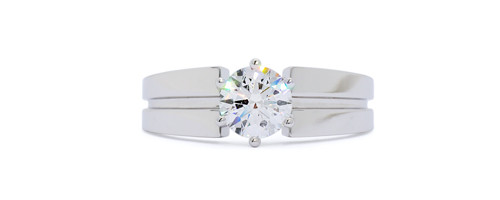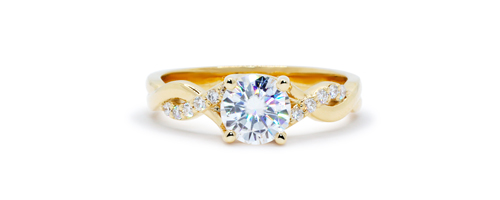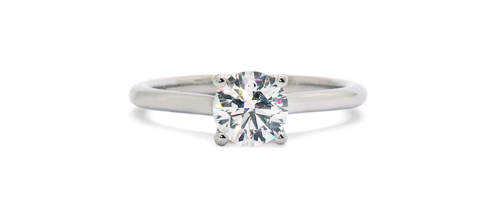La moissanite, une bonne alternative au diamant?
Introduction
Depuis quelques années, la pierre synthétique appelée moissanite gagne en popularité. Les consommateurs qui recherchent une alternative au diamant se tournent naturellement vers cette pierre de synthèse pour des raisons éthiques et financières mais aussi parce que la moissanite est une très belle pierre.
La moissanite n’est ni un diamant synthétique ni un diamant artificiel et même si elle ressemble à s’y méprendre au diamant, cette pierre possède sa propre identité et sa propre constitution chimique. Cet article a pour but de vous familiariser avec cette pierre unique, de connaître ses avantages, ses différences et l’entretien qu’elle nécessite pour rester belle et brillante.
D'où vient la moissanite?
En 1893, le chimiste français Henri Moissan découvre le premier éclat de moissanite à l’état naturel dans un canyon de l’Arizona aux États-Unis. Une météorite tombée il y a 50 000 ans en est la cause. Croyant d'abord à des cristaux de diamant, Henri Moissan conclue en 1904 qu’il s’agit de carbure de silicium (SiC) et non de carbone (C). C’est donc en l’honneur de ce premier lauréat du prix Nobel de chimie que cette rareté venue du ciel fût nommée moissanite.

Henri Moissan
La moissanite utilisée en joaillerie est une pierre créée en laboratoire puisqu’elle est pratiquement inexistante à l’état naturel. La maison Charles & Colvard, située en Caroline du Nord, É.-U. est le premier et l’un des plus importants fabricants de moissanite au monde. Le progrès des dernières années leur a permis de fabriquer une pierre de très grande qualité et d’une rare beauté.
Les propriétés de la moissanite et sa dureté comparables à celles du diamant intriguent les amateurs de grosses pierres. Et les prix d’une bague de fiançailles avec une moissanite de 1 carat ou d’une moissanite de 2 carats sont beaucoup moins élevés que celles avec un diamant de même taille. C’est beaucoup de points positifs pour cette pierre, ne trouvez-vous pas? Attendez d’en connaître la suite.
Comparaison entre la moissanite et le diamant
En termes de dureté, moissanite vs diamant, c’est pratiquement la même résistance aux chocs. Toutes les pierres sont répertoriées de 1 à 10 selon un système de classification appelé échelle de Mohs. La moissanite est l’une des mieux classées avec un 9.5 ce qui en fait une pierre pratiquement inusable. Seul le diamant la devance se classant tout en haut à 10. Cette très légère différence de dureté entre la moissanite et le diamant n’a pratiquement aucune incidence en joaillerie.
Pour ce qui est de l’apparence, il faut un œil entraîné pour noter la différence entre une moissanite et un diamant. De loin, on n’y voit que du feu. Pour départager ces deux pierres, les joailliers étudient d’abord son éclat puisque la moissanite possède un indice de réfraction supérieur à celui du diamant. Elle disperse mieux la lumière et lorsque bien éclairée, la pierre offre plus de brillance et plus de reflets couleurs de l’arc-en-ciel.
Si la moissanite est une pierre qui vous intéresse pour ces qualités, attendez de vous laisser convaincre par son prix. Une moissanite de la même taille qu’un diamant naturel de 1 carat coûte dix fois moins cher que celui-ci. Cette différence de prix permet à beaucoup de jeunes fiancées d’obtenir la bague avec la grosseur de pierre qu’elles désirent. Faites vous-même la comparaison entre nos bagues avec moissanite et nos bagues avec diamant. De plus, cette pierre faite de carbure de silicium est un choix éthique et éco-responsable.
Comparaison entre la moissanite et les autres pierres précieuses
Confondue à tort avec ce que l’on appelle communément un cubique ou un CZ (oxyde de zirconium), la moissanite est extrêmement résistante comparativement à cette autre pierre synthétique. Alors si vous avez à choisir entre cubic zirconia vs moissanite pour votre bague de fiançailles, la moissanite est un choix beaucoup plus éclairé.
Avantages de la moissanite
La moissanite de synthèse se distingue sur trois points en particulier.
- Son prix est moins élevé que le diamant de laboratoire. On parle ici d’une différence notable pour une pierre synthétique de qualité.
- Son procédé de fabrication est contrôlé, éco-responsable et éthique.
- La pierre est disponible dans toutes les grosseurs et toutes les tailles (formes).
4 critères à considérer dans le choix d'une moissanite
- La solidité de la moissanite se situe à 9,5 sur l’échelle de Mohs.
- La brillance de la moissanite affiche un indice de réfraction supérieur au diamant.
- Le coût de la moissanite est inférieur à celui du diamant.
- La provenance de la moissanite dont le bilan carbone de production en laboratoire n'est pas neutre mais bien loin des dommages causés par l'extraction minière.
Entretien et soins pour la moissanite
Nous conseillons deux façons de nettoyer une moissanite :
- Tremper quelques secondes dans une machine à ultra-sons.
- Frotter légèrement avec une brosse à dent et du savon à vaisselle.
L’entretien d’une moissanite se fait habituellement dans un atelier de joaillerie de confiance qui assure en même temps la solidité des griffes sur lesquelles elle est sertie. Un bijou paré de cette pierre que l'on porte au quotidien devrait être entretenu au moins une fois par année.
Conclusion
La moissanite est une bonne alternative au diamant. Sa solidité, sa brillance, son coût et sa provenance sont tous des éléments qui penchent en sa faveur. Mais soyez bien conscient que la moissanite n’est pas un diamant et qu'elle ne le remplacera jamais. Il faut aimer cette pierre pour ce qu’elle est.
Finalement, que ce soit pour votre bague de fiançailles, jonc de mariage ou tout autre bijou que vous aimeriez offrir ou vous offrir, il sera maintenant plus facile pour vous de savoir si la moissanite est une pierre qui convient à vos goûts, à vos valeurs et à votre portefeuille. Jetez d’ailleurs un œil sur notre sélection de bagues faites à la main avec des moissanites. Vous ne trouvez pas exactement ce qu’il vous plaît? N’hésitez pas à prendre rendez-vous avec nous pour une création sur mesure.
FAQ
- Est-ce que la moissanite est plus durable que les diamants? Cette pierre faite de carbure de silicium est presque aussi résistante aux chocs que le diamant.
- La moissanite est-elle considérée comme une pierre précieuse? Non, la moissanite n’est ni une pierre précieuse, ni une pierre semi-précieuse.
- Est-ce que la moissanite raye facilement? Non, c'est une pierre extrêmement résistante aux rayures.
- La moissanite peut-elle être considérée comme une alternative éthique aux diamants? Oui, son procédé de fabrication et de distribution est en tout point éthique.
- Comment la moissanite est-elle fabriquée? Elle est cultivée en laboratoire grâce à une machine à technique HPHT (Haute pression, haute température).
Obtenez une consultation en ligne avec l'une de nos joaillières dès aujourd'hui.



